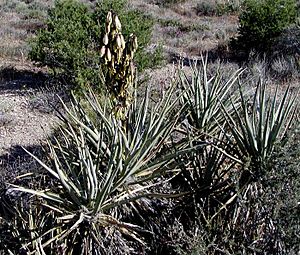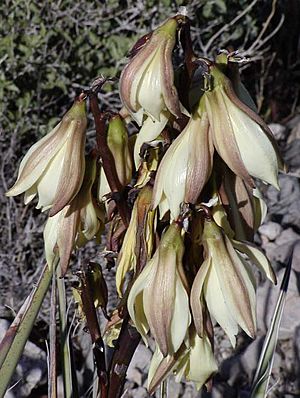Banana yucca facts for kids
Quick facts for kids Banana yucca |
|
|---|---|
 |
|
| Yucca baccata at Red Rock Canyon | |
| Conservation status | |
| Scientific classification | |
| Synonyms | |
|
The Banana Yucca (also called Datil Yucca or Spanish Bayonet) is a common plant. It grows in the deserts of the southwestern United States and northwestern Mexico. You can find it from southeastern California north to Utah, and east to western Texas. It also grows south into parts of Sonora and Chihuahua in Mexico. Some even say it grows in Colombia.
This plant gets its common name "banana yucca" from its banana-shaped fruit. The word "baccata" in its scientific name means 'with berries'. The Banana Yucca is related to the Mojave Yucca. They sometimes grow in the same areas. When they do, they can even create hybrid plants.
Contents
What Does the Banana Yucca Look Like?
The Banana Yucca has long, blue-green leaves. They are usually about 50 to 76 cm long. This plant often has a very short trunk, or no trunk at all.
It blooms in the spring. This usually happens from April to July, depending on where it grows. The flowers are white to cream-colored. They often have purple shades. Each flower is about 5 to 13 cm long. The flower stalk is not very tall, usually 1 to 1.5 meters high.
The seeds are rough and black. They are about 3 to 8 mm long and wide. The seeds ripen in about 6 to 8 weeks. The fleshy fruit is 8 to 18 cm long and 6 cm wide. It tastes a bit like a sweet potato.
Who Lives on the Banana Yucca?
The Banana Yucca is a home for certain insects. It is a place where the young (larvae) of the ursine giant skipper and yucca giant skipper live. Various yucca moths also live there. After eating, the skippers turn into pupae in the yucca's roots.
Kinds of Banana Yucca
The Banana Yucca has been divided into three main types, called subspecies:
- Yucca baccata ssp. baccata—This is the common Datil Yucca or Banana Yucca.
- Yucca baccata ssp. thornberi (McKelvey) Hochstätter—This is Thornber's Yucca.
- Yucca baccata ssp. vespertina (McKelvey) Hochstätter—This is the Mohave Datil Yucca.
Where Does the Banana Yucca Grow?
This plant is found in many desert areas. These include the Great Basin, the Mojave, Sonoran, and Chihuahuan Deserts. It also grows in the mountains of Arizona and New Mexico. You can find it in the lower parts of the Rocky Mountains.
It mainly grows in the states of Utah, California, Nevada, Arizona, Colorado, New Mexico, and Texas in the United States. It also grows in the state of Chihuahua in Mexico.
You can find it in different types of places. These include Pinyon-Juniper forests, desert grasslands, and areas with Creosote bush scrub. It also grows in Sagebrush and Ponderosa pine areas. It usually grows at heights between 1,500 and 2,500 meters.
The Banana Yucca often grows near other plants. These include Yucca schidigera, Yucca brevifolia, Yucca arizonica, and Yucca faxoniana. It also grows near different types of Agave plants. You might also see it among Sclerocactus, Pediocactus, Navajoa, and Toumeya species.
The Banana Yucca grows across a large part of the North American deserts. Because of this, it can look a bit different depending on where it grows. Yucca plants from the higher, mountainous parts of the Rocky Mountains are very strong. They can handle very cold winters and tough conditions.
How People Use Banana Yucca
The Paiutes used to dry the fruits of the Banana Yucca. They would save them to eat during the winter. Even today, it is a popular food among some Mexican Indigenous groups.
The young flower stalks can be cooked and eaten. You just need to remove the tough outer skin. The fruit can be eaten raw or cooked.
See also
 In Spanish: Yuca banana para niños
In Spanish: Yuca banana para niños



